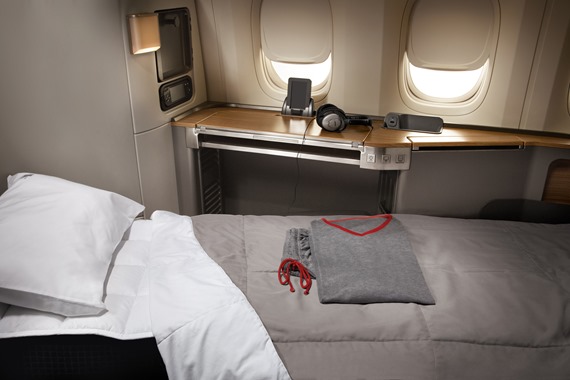NOTICE: This post references card features that have changed, expired, or are not currently available
At its most basic level, the frequent flyer game goes like this:
- Use tricks to earn lots of miles quickly
- Spend those miles on international luxury flights
An ingrained belief in this hobby is that the best way to maximize value from your miles is to spend them on international luxury flights. But is that true? I’ve often run analyses showing that using the same tricks to earn cash instead of miles can get you further in your travels, especially with domestic flights (with a few significant exceptions). For example, I published a series of posts that showed that cash is often the best option when it comes to hotel stays:
For this post, I followed the pattern of the hotel analyses: I compared multiple manufactured spend approaches (including earning miles or earning cash) to see which was best for international travel.

Best credit cards
In my recent post, “Manufacturing miles for free flights,” I suggested the following credit cards for manufacturing miles:
- Chase Ink Plus: Earns 5 points per dollar at office supply stores. Points transfer to several airline programs. Visa gift cards can be bought at office supply stores with max value of $200.
- Amex EveryDay Preferred: Earns up to 4.5 points per dollar at grocery stores and up to 3 points per dollar at gas stations (requires using the card 30 times per billing cycle to reach 4.5X and 3X, respectively). Points transfer to many airline programs. Visa gift cards can be bought at grocery stores and some gas stations with max value of $500.
- Diner’s Club Elite card: Earns 3 points per dollar at grocery stores and drug stores. Points transferable to many airline programs. By transferring points first to SPG, then to airline miles, many more programs become available at an effective rate of 2.25 miles per dollar (see prior post for details). Visa gift cards can be bought at grocery stores and drug stores with max value of $500.
Analysis Approach
For this analysis, I selected a few airline programs (American, Delta, and United) to see how much manufactured spend would be required to fly internationally in coach, business class, and first class using miles from those programs. I compared these results to another option: manufacturing cash.
Routes and dates
I used the following specific routes for this analysis:
- US to Europe: Denver (DEN) to Paris (CDG)
- US to Southern South America (coach and business): Denver (DEN) to Santiago (SCL)
- US to Southern South America (first class): JFK to Santiago (SCL) – First class wasn’t available from Denver for the dates I used.
- US to South Africa: Denver (DEN) to Johannesburg (JNB)
- US to Hong Kong: Denver (DEN) to Hong Kong (HKG)
- US to Australia: Denver (DEN) to Sydney (SYD)
I used each program’s award charts to determine the award prices. To estimate cash prices, I plugged in each of the above routes to Google Flights and chose the least expensive option each time. Since specific dates were required, I somewhat arbitrarily chose the middle of July: July 11 to July 18 2015.
Calculations
For each route, cabin type, and airline combination, I calculated the number of miles required for the flight, the amount of credit card category spend that would be required, and how many gift cards one would have to buy to get there. My thought is that the less spend and the fewer gift cards required, the better. Another important component is the total gift card fees involved, so I calculated that as well.
I did not include expected fuel surcharges or other fees involved in booking award flights in this analysis. I also did not consider credit card annual fees, cost of liquidating gift cards, or the number of points earned from gift card fees.
Assumptions
To collect American Airlines miles, I assumed the use of the Diner’s Club Elite card. I assumed that the cardholder would use the card to buy $500 gift cards at grocery stores or drug stores and that each gift card would have a $5.95 fee. The cardholder would earn 3 Diner’s Club points per dollar and would transfer those points to SPG and then to American Airlines for an effective rate of 2.25 miles per dollar.
To collect United Airlines miles, I assumed the use of Chase Ink cards. I assumed that the cardholder would use the cards to buy $200 gift cards at Staples and that each card would have a $6.95 fee, which is reduced to $4.88 when accounting for the Visa Savings Edge rebate. In the process, the cardholder would earn 5 Ultimate Rewards points per dollar and would transfer those points one to one to United Airlines as needed.
To collect Delta Airlines miles, I assumed the use of either the Diner’s Club card at grocery stores and drug stores, or the EveryDay Preferred card at gas stations (the grocery store benefit with this card is capped at $6500 spend per year so I left that one out). Either way, the cardholder earns the equivalent of 3 miles per dollar. I assumed that the cardholder would use the cards to buy $500 gift cards, each with a $5.95 fee. I did not model the cost of transferring points to Delta with Membership Rewards points (the fee is capped at a maximum of $99 per transfer).
To collect cash, I assumed the use of a credit card that offers 5% cash back at grocery stores (see “Playing 5X everywhere Whack a Mole”). I assumed that the cardholder would use the card to buy $500 gift cards, each with a $5.95 fee.
Results
Below are the results broken down by economy, business class, and first class. Values in the tables are averaged across destinations.
Note that due to the fact that Delta saver level awards are often hard to find, I also included mid-level awards which tend to be widely available. And, with United, I included two rows: United and United Partner. On business class and first class international flights, United charges considerably more points for partner awards so I thought it was important to capture that distinction here.
International Economy
| Miles Used | Average Award Price | Average Total Spend Required | Average # gift cards required | Average Total Fees |
| United | 72,000 | $14,400 | 72 | $351 |
| American | 68,000 | $30,222 | 61 | $363 |
| Delta | 78,000 | $26,000 | 52 | $311 |
| Cash | $1,797 | $35,944 | 72 | $431 |
| Delta mid-tier | 120,000 | $40,000 | 80 | $478 |
The above table is sorted by the average total spend required. As you can see, for example, the average award price in my sample for United international economy awards is 72,000 miles. And, it requires only $14,400 of spend at 5X to earn the required miles.
I think that the most interesting columns are the last two:
- Number of gift cards required is an estimate of the work involved in manufacturing this much spend.
- Total fees is an objective number showing the out of pocket cost for manufacturing this much spend (not including fees, if any, for liquidating gift cards)
As you can see in the table above, there isn’t a huge difference in the amount of work required with any of these options (# of gift cards required ranges from 52 to 80), and the fees are fairly similar too ($311 to $478). As a result, its not clear that any method is significantly better than others for manufacturing international economy flights.
International Business Class
| Miles Used | Average Award Price | Average Total Spend Required | Average # gift cards required | Average Total Fees |
| United | 129,000 | $25,800 | 129 | $630 |
| United Partner | 146,000 | $29,200 | 146 | $712 |
| American | 117,000 | $52,000 | 104 | $621 |
| Delta | 142,000 | $47,333 | 95 | $566 |
| Delta mid-tier | 226,000 | $75,333 | 151 | $898 |
| Cash | $5,876 | $117,524 | 236 | $1,402 |
With international business class awards we start to see a big difference in outcome between manufacturing miles and manufacturing cash. The number of gift cards required when manufacturing miles, ranges from 95 to 151. The number of gift cards required for manufacturing cash, meanwhile is way higher at 236. Similarly, fees for manufacturing miles range from $630 to $898 whereas fees for manufacturing cash come to a whopping $1,402.
International First Class
| Miles Used | Average Award Price | Average Total Spend Required | Average # gift cards required | Average Total Fees |
| United | 158,000 | $31,600 | 158 | $771 |
| United Partner | 228,000 | $45,600 | 228 | $1,113 |
| American | 144,000 | $64,000 | 129 | $765 |
| Cash | $11,146 | $222,916 | 446 | $2,655 |
With international first class awards, the trends in favor of miles over cash are even more pronounced. You’ll notice that Delta is not included in this analysis since Delta does not allow for international first class awards. With United and American, the number of gift cards required ranges from 129 to 228. And, the number of gift cards required for manufacturing cash is far bigger: 446. Similarly, fees for manufacturing miles range from $765 to $1,113 whereas fees for manufacturing cash come to $2,655.
Conclusion
If your goal is international economy travel, there’s no clear advantage between manufacturing miles vs. manufacturing cash. In fact, if you care about elite status, cash may have the advantage since flights purchased with cash will earn elite qualifying miles.
If your goal is international business or first class, then miles are clearly the way to go. Even Delta mid-tier awards and United partner awards look reasonable when compared to cash based options.





On your chart which cards did you use to get the cash and how?
Cards that offer 5% cash back. See this post: https://frequentmiler.com/2014/01/09/playing-5x-everywhere-whack-a-mole/
Like that insurance commercial…….everybody knows that………..but it never hurts to have the fundamentals drilled home……….
You didn’t include Alaska Airlines miles, which transfer 1:1 from Diner’s Club. There’s great redemptions using Alaska Airlines miles, such as off-peak awards from the US to Japan for 50K.
True. This wasn’t meant to be a complete list, but Alaska is a particularly good option
Very good analysis but I also read your previous analysis for hotel stays and I found something that it can change your analysis: for SPG,Club Carlson and Arrival if you buy Amex Gift Card through portal then not only you stay free but also make money. Those posts are in mid August which Amex GC had average 2.5% CB. For example by buying 10000 Amex GC there was possibility of free stay + $190 ($250-$60).
Yes that’s true. REDbird also changes the analysis. To me, the most important factor is the number of gift cards one has to deal with since that’s the biggest pain point (for me, anyway), not the fees.
Why did you choose DEN? It’s nice having analysis done on my home airport…but was this because it’s the most centrally located (in the USA) major airport?
I threw a mental dart at a mental map of the country and it landed in Denver. In other words, no particular reason.
yes much slower lately for me too
Not sure where else to post this, but the video ads on your site are slowing down the page loads considerably for me. I’m not sure if this is happening to others, but thought I’d share.
Thanks. That’s not good. I’ve asked Boarding Area to look into it.
Thanks again for your thoughtful, fresh input on this.
Grat article, and I like comparition chart as well. I have Chase Ink Bold and my plan is to collect enough ticket for family to travel to Southeast Asia. I just realized there is a Diner’s Club credit card but annual fee crazy high. Is it worst to own that card and manufacturing point in overall?
Thank a lot.
If you need a lot of miles for international travel, and can’t get them through signup bonuses, then yes the Diners Club card is probably worth the $300 fee.
You include delta mid tier because of poor availability with delta low tier. Thus you should also take into account that
1) AA has very very bad saver avail on TATLs
2) UA has bad saver avail on its metal
3) after UA deval, you have wide open partner availability
Also take into account that with UR and DC you can transfer to things like BA and SQ which have good availability and lower miles cost but fuel surcharges. And fuel charges are only a $ amt, they don’t require any “time”
Good points, but I wasn’t trying to show every combination of everything here. I was just looking at a few commonly used programs to see how well they compete with cash for international flights.
Something is wrong with that Delta biz mid tier row.
50% more miles takes 20% more spend?
Good catch. My spreadsheet had the wrong multiplier for Delta on many rows. Fixed.